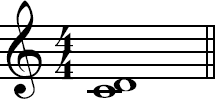Major second interval
 The major second interval consists of two notes with one whole step distance. For example, the interval from C to D will result in this musical interval.
The major second interval consists of two notes with one whole step distance. For example, the interval from C to D will result in this musical interval.
The major second interval is abbreviated as M2, whereas the minor second is abbreviated as m2. An alternate naming of the major second is the diminished third.

A major second with C to D on the keyboard.
Listen to the major second interval (C-D):
In scales, this interval is the most frequent. In major scales, the major second interval is represented five times. For example, in C Major (C, D, E, F, G, A, B), the major seconds are C-D, D-E, F-G, G-A and A-B.
The major second is also present in some chords, such as sus2 and add2. The number two is pointing out that a second interval is included in the chord. For example, Csus2 consists of the notes C, D, G.
To be able to distinguish this interval by ear, a good idea is to think of familiar songs whose first notes match. M2 ascending examples are "Brother John" and "Silent Night".
A major ninth interval is the same as major second but in the next interval (or compound major second, which is the correct term).
Ascending major second intervals
A list of ascending major second intervals:
- C – D
- C#/Db – D#/Eb
- D – E
- D#/Eb – F
- E – F#
- F – G
- F#/Gb – G#/Ab
- G – A
- G#/Ab – A#/Bb
- A – B
- A#/Bb – C
- B – C#
Descending major second intervals
A list of descending major second intervals:
- C#/Db – B
- D – C
- D#/Eb – C#/Db
- E – D
- F – D#/Eb
- F#/Gb – E
- G – F
- G#/Ab – F#/Gb
- A – G
- A#/Bb – G#/Ab
- B – A
- C – A#/Bb
Enharmonic notes such as Cb and Fb are omitted.
Read more about intervals and use the interactive Piano Interval Finder tool.